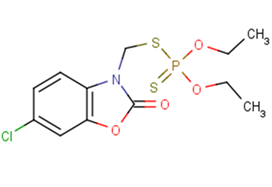
Phosalone
CAS No. 2310-17-0
Phosalone( —— )
Catalog No. M20420 CAS No. 2310-17-0
Phosalone is an organophosphate chemical commonly used as an insecticide and acaricide.
Purity : >98% (HPLC)
 COA
COA
 Datasheet
Datasheet
 HNMR
HNMR
 HPLC
HPLC
 MSDS
MSDS
 Handing Instructions
Handing Instructions
| Size | Price / USD | Stock | Quantity |
| 500MG | 38 | In Stock |


|
| 1G | Get Quote | In Stock |


|
Biological Information
-
Product NamePhosalone
-
NoteResearch use only, not for human use.
-
Brief DescriptionPhosalone is an organophosphate chemical commonly used as an insecticide and acaricide.
-
DescriptionPhosalone is an organophosphate chemical commonly used as an insecticide and acaricide.
-
In Vitro——
-
In Vivo——
-
Synonyms——
-
PathwayOthers
-
TargetOther Targets
-
RecptorOthers
-
Research Area——
-
Indication——
Chemical Information
-
CAS Number2310-17-0
-
Formula Weight367.81
-
Molecular FormulaC12H15ClNO4PS2
-
Purity>98% (HPLC)
-
SolubilityDMSO:41 mg/mL (111.47 mM)
-
SMILESCCOP(=S)(OCC)SCn1c2ccc(Cl)cc2oc1=O
-
Chemical NameS-((6-chloro-2-oxobenzo[d]oxazol-3(2H)-yl)methyl) OO-diethyl phosphorodithioate
Shipping & Storage Information
-
Storage(-20℃)
-
ShippingWith Ice Pack
-
Stability≥ 2 years
Reference
1.Baeeri M Momtaz S Navaei-Nigjeh M et al. Molecular evidence on the protective effect of ellagic acid on phosalone-induced senescence in rat embryonic fibroblast cells[J]. Food and Chemical Toxicology 2017 100:8-23.
molnova catalog



related products
-
6-Hydroxy-4-methylco...
6-Hydroxy-4-Methylcoumarin is a useful research chemical.
-
DLinDAP
DLinDAP (D-LinDAP) is an ionizable cationic lipid used for SiRNA delivery.
-
1-39-Corticotropin (...
Adrenocorticotropic Hormone (ACTH) (1-39) human(TFA),a member of the melanocortin family, is a melanocortin receptor agonist. It stimulates production of CS by the adrenals, but melanocortin receptors are also found in the central nervous system (CNS) and on immune cells.



 Cart
Cart
 sales@molnova.com
sales@molnova.com


